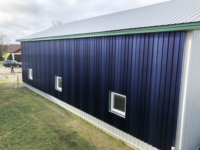ATAS International has been involved in the manufacturing of transpired solar collector panels since 2002. Technical insights gleaned from early projects resulted in continual refinement of design, ultimately culminating in the release of the InSpire wall solar air heating system to the sustainable construction industry in 2006. Since then, InSpire has been installed on a wide variety of building types including schools, warehouses, and office buildings, earning numerous industry awards and professional recognition along the way.
A new website for InSpire was launched in mid-April: www.inspirewall.com, with a nod to the 50th anniversary of Earth Day. The new site contains more project data and photos, applications and case studies, and real-time performance data of a system installed on a warehouse/production facility. Design considerations, a BIM model, CAD details (in PDF and DWG formats) and color selections are also available on the new site.
Heating outside air is often the single most expensive energy budget item in a building and this is what the solar air wall system helps to reduce.Solar air heating is a simple, renewable, and efficient technology using the sun as a source of heat. Transpired solar collector panels installed on building walls can be used for heating building space with pre-heated outside air and can also provide process hot air for drying applications across numerous industries. The solar thermal efficiency of the InSpire wall can exceed 80%, as certified by the Solar Rating and Certification Corporation (SRCC). Christian Vachon, Director of Solar Technology for ATAS International, stated, “I have been selling and installing the InSpire solar air heating panels for over 10 years and they have always met or even exceeded calculated performance.”
The InSpire solar collector is a perforated aluminum or zinc wall panel that is usually mounted on a building over the south-facing weathertight exterior wall (southeast and southwest-facing walls are also adequate to provide preheated air). The precision perforations in the wall panels allow outside air to travel through the face of the panel. When the metal panel is exposed to sunlight, it heats up, creating a layer of warm air on the surface of the panel. This solar-heated air is drawn through the perforations where it rises through the plenum between the two walls and enters the building’s central ventilation system or supply fan where it is distributed through the building’s duct work.
To learn more about solar air heating, ATAS offers a course on the topic that is approved by the American Institute of Architects (AIA) for 1 LU/HSW and by Green Business Certification, Inc. (GBCI) for 1 CE hour. You may request a seminar through the resources tab on the new InSpire website.










